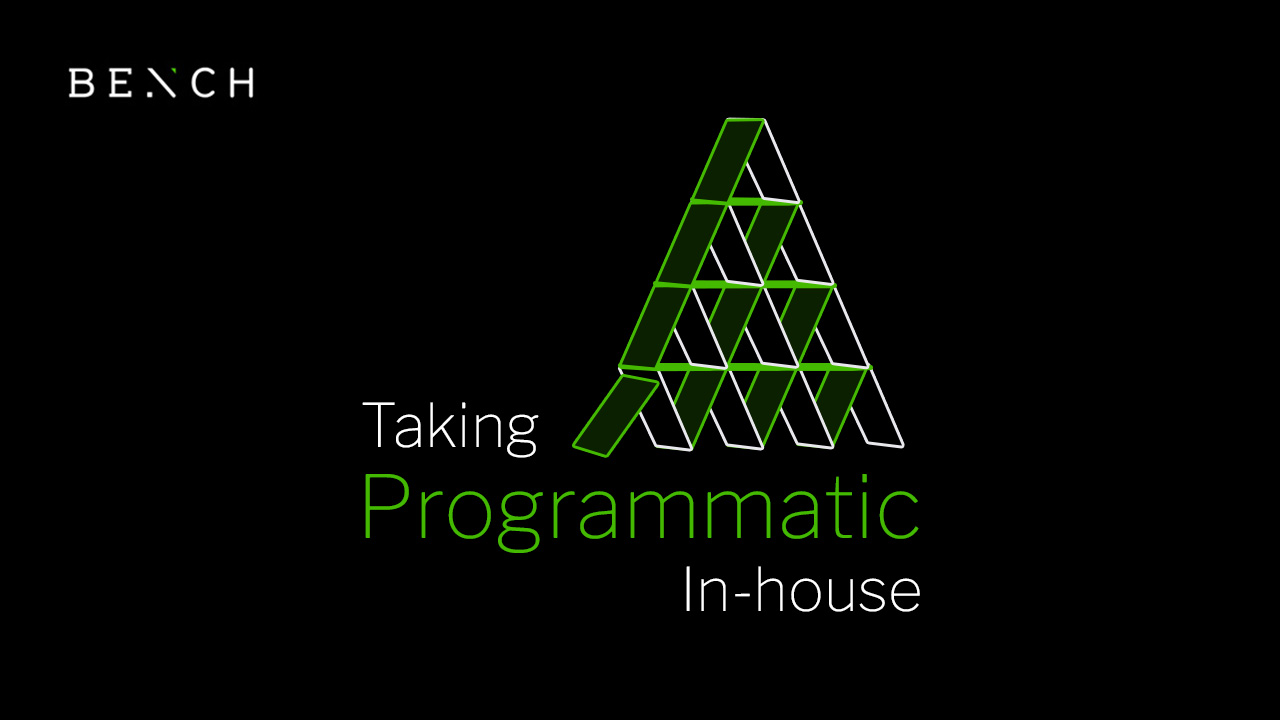AdWeek reported the other day that 86% of brands are considering taking a portion of their programmatic spend in-house. This data is based on a recent survey conducted by programmatic agency, Infectious Media.
Another piece of research undertaken in 2017 by Advertiser Perceptions found that half of respondents agreed that managing programmatic will eventually fall into the laps of brands.
For a vast majority of marketers, this is not that different from being asked to join an astronaut training program.
Brand to Media Agency: “I’m losing my religion…”
Truth be told, a lot of the talk about taking things into their own hands is less to do with wanting to improve advertising yield and heavily to do with brands losing faith in outsourced suppliers.
Over 50% of marketers believe that the programmatic agency model is beyond repair. Brands are exhibiting serious trust withdrawal symptoms and agencies aren’t doing much to alleviate these.
As a result, all signs point to the possibility that in 2018 marketers will need to start brushing up on rocket science in order to launch their in-house programmatic divisions.
Or at the very least, hire a technology whiz or two whose sole responsibility will be to wrangle the dozen or so systems that make a typical programmatic stack.
So What’s Changed In the Last Few Years?
In 2015, we speculated whether agencies would take programmatic in-house. But the issue of agencies doing so is no longer the hot topic, it’s clear that they have mostly failed at the task.
Need proof? A whopping 71% of marketers believe that media agencies have done a poor job of adapting to the realities of programmatic marketing.
As a result of getting cold feet with outsourced help, it is now brands who are dipping their toes in the programmatic waters.
Some are just testing the surface while others have taken the full plunge and built entire teams dedicated to the task.
This is a seismic shift that’s significantly redressing the power balance between media agencies, AdTech providers, publishers and brands.
But Everybody’s (Brand Is) Doing It
Some of the world’s largest consumer-facing brands, in diverse industries, have launched a programmatic marketing arm this year or shifted a sizeable portion of their spend in-house:
This shows that marketers are not about to give up on programmatic, warts and all.
Despite the agency finger-pointing and transparency blood-letting, 2017 has been another watershed year for automated ad buying. There are some hefty stats available to prove that programmatic is eating the advertising industry.
Some companies are also heavily pushing the boundaries when it comes to programmatic buying. For instance, Adobe ran the world’s first ad campaign this month executed entirely using an automated approach.
This certainly sets the scene for what is to come in 2018.
Why Media Agencies Are NOT Dead in The Water
But let’s stop gazing into the programmatic crystal ball for a moment and look at the cold, hard facts of the present. These facts will show that on the list of Ad Age’s top 200 marketers, only 15 have brought their programmatic in-house.
This number represents only 7.5% of this small, albeit influential, US-based group of 800-pound advertising gorillas. Which is miniscule if taken as a percentage of the world’s total advertiser pool. Viewed from this angle, the recent spate of activity is but a drop in the global media ocean.
The remaining 99% of the world’s brands will continue to rely on outsourced programmatic buying services in the foreseeable future.
This is corroborated by the Infectious Media survey mentioned earlier, which found that 96% of its respondents would happily hand over the reigns to agencies so they can manage certain parts of the media buying process.
Brands still believe agencies play an important role in the programmatic ecosystem, they just don’t trust them all that much.
So, despite the lofty pronouncements made by certain advertising behemoths and the difficulties that plague programmatic advertising, taking the function in-house is too complex for most marketing teams to even entertain. Even for those brands that wield multi-million-dollar media budgets.
Is $20 Million The Magic Number?
Wayne Blodwell, The Programmatic Advisory CEO, says that $20 million is the minimum spend required to justify the upfront investment in building an internal programmatic function.
In addition to proposing this ‘magic number,’ Wayne provides a useful model for assessing an in-house marketing team’s readiness, which is built around these four pillars:
- Investment
- Talent
- Measurement
- Technology.
Yet, despite Wayne’s assertion, it’s not a given that only brands with substantial ad spend under their command should look to bring programmatic in-house.
Software tools for marketers have been evolving and platforms are now available that help small-to-medium sized marketing teams manage programmatic campaigns effectively on their own.
Some cross-channel media buying platforms make programmatic ad inventory accessible to marketers who aren’t specialists.
In fact, using these tools, even a small tech startup can scale to 68 different countries using programmatic marketing.
Your primary consideration shouldn’t be the size of your media budget but whether you are using the right technology, and have appropriate people and processes in place. Building a programmatic media stack the size of the Eiffel tower is impossible for the majority of marketing teams.
Nor should this be your goal.
In-house Or Otherwise, You Can’t Avoid the Legwork
At the Digital Espresso event held earlier this year, Gil Snir, Bench’s CCO, talked about the trials and tribulations of taking programmatic in-house:
The key takeaway from the talk is that programmatic is a viable method for buying ad inventory regardless of marketing team size. Moreso, Gil stresses that:
Programmatic, despite its many criticisms is still the biggest innovation in media buying.
Regardless of whether you decide to take programmatic in-house or not, the end goal is to achieve greater results from a similar or smaller media investment. Curious to find out how?
Bench contributed a piece to the 2017 IAB Programmatic Playbook outlining what you need to do to successfully start executing on an in-house programmatic strategy.
It is a path that, whether using external or internal resources, will require certain steps to be taken in order to maximise and then safeguard your media investment. In both instances, these steps are similar.
As pointed out earlier, agencies aren’t going anywhere. But neither do you need to be on the Ad Age ‘Top 200’ list to take control of your brand’s media destiny.
What’s a marketer to do then?
The Programmatic House Your Brand Built
The first order of priority is to assess your current media buying ‘habits’ and see how much of that is done programmatically. Of your overall channel mix, what is the split between display, social video or mobile?
There are many questions that need to be answered but you can use this as a good starting point:
If the majority of your ad spend is digital and you are running social, video, display or mobile campaigns then enhancing your in-house programmatic buying capabilities could be the right strategic move.
Bench’s Gil offers ‘STOMP’ as a high-level framework to help with getting your head around this undertaking:
- Strategy
- Technology
- Operations
- Media
- Price / Value
To learn more about how to apply STOMP to your situation, watch the recording of Gil Snir’s Digital Espresso presentation.
Too Much, Too Fast, Too Soon – Avoiding the Pitfalls
You also want to be aware of the main underwater stones that can trip you up on your implementation journey:
- The Master Plan
One of the primary pitfalls a marketer encounters is the lack of best-practice for how to manage a brand-side programmatic operation. Agencies and technology solution providers have ‘been at it’ for quite a few years but brands are on the back foot when it comes to processes and operational know-how. This includes a lack of experience with building a supporting management framework, including setting the right KPIs.
- The Tech Tax
When working through an agency, a brand marketer does not have to deal with the detailed financials of automated ad buys. However, you will now have to learn about programmatic tech tax firsthand. Performance reporting becomes its own challenge and so does the like-for-like measurement of ROI across channels.
- The Sources
Acquisition of media sources has to be ongoing and in a way that is brand-safe, which is a momentous task given how quickly these change. With each new source that’s added, brand safety concerns have to be allayed. This all involves much time and effort, multiplied by the amount of channels you advertise on.
- The Technology
- The Talent.
Talent and technology are so important that we’ll explore each topic in more detail below.
Climbing The MAdTech Everest
The first mountain you’ll have to ascend is that of your new programmatic stack.
And with each passing year, this mountain keeps getting higher, the learning curve grows ever-so-steeper and reaching even the equivalent of base camp becomes a challenge. The 2017 Marketing Technology Lumascape is not for the faint of heart, especially if you’re the one tasked with choosing the right ingredients from this MAdTech heap.
Interestingly, as the number of technology solutions grows, the amount of money spent by CMOs has declined in 2017. This is partly to do with vendors under-delivering on promises and not passing P&L scrutiny.
It’s not all doom-and-gloom though. There are programmatic advertising platforms that allow you to simplify the management of multi-channel campaigns by bringing everything together into a unified system.
However, such truly channel-agnostic solutions are still few and far in between as each DSP or channel-focused offering will try to sell you on their version of the truth.
Be wary of such myopic channel-fixation as this can make your marketing strategy vulnerable to the vagaries of a single platform.
A Small Question of the Sizeable Talent Gap
Still have ambitions to take programmatic into your own hands and nothing that you’ve read up until now has deterred you?
The reality is that, once you overcome the tech hurdles, you’ll then have to confront the very real skill shortage that exists in the industry globally. In his Digital Espresso presentation, Gil Snir mentioned that when it comes to finding talent:
The programmatic recruitment pool is dry and water isn’t cheap.
This is supported statistically by a recent survey carried out by the World Federation of Advertisers which found that:
65% of marketing hiring managers are afraid they won’t be able to hire enough programmatic specialists.
This sentiment applies internationally as programmatic talent is in short supply and mainly situated in cities that act as global media hubs. If you’re thinking of building a new team, then this needs to be a primary consideration.
Even in large cities, your new programmatic recruit will be moving from an agency and will have a range of other job options for which they can demand a top-tier salary. These agency-side candidates may also fear that they won’t develop as much client-side in a professional sense as they would in a cutting-edge media agency environment.
A realistic assessment needs to be done to figure out if your brand and marketing team structure present an interesting enough career opportunity for a potential candidate.
Some Like It Hybrid
If you’ve decided that your marketing house isn’t big enough to accommodate a full-blown programmatic team but still want to in-source some components, a hybrid model could be the way to go. Some brands, such as P&G, have opted for a hybrid model that involves engaging a mix of technology and service providers. In fact, the aforementioned Infectious Media study established that:
A hybrid model could become the standard way of running a programmatic function.
Operating a hybrid model can give you control over those elements of the programmatic supply chain that you wish to keep a watchful eye over. Going further still and opting for an on-site agency model can also give you the benefit of being able to scale resources up or down depending on your marketing needs.
Running a hybrid model could give you just the right level of flexibility without consuming all of your financial and people resources.
There are several programmatic marketing platforms that have a managed service arm to help you worry less about the technology while remaining in total control of your media investment.
To Own Your RTB or Just Let Your Agency Be?
The question is definitely not a philosophical one.
Attempting to take programmatic in-house can quickly turn into a falling house of cards if it’s not planned correctly and managed strategically. However, the triple-whammy of increased control, transparency and cost savings can be enough to warrant a serious investigation into whether you should manage programmatic on home turf.
If you’re seriously looking at making the move then it will become one of the most significant undertakings your marketing team will attempt in 2018.
Plan accordingly and don’t rush it. Because programmatic media buying is here to stay.




